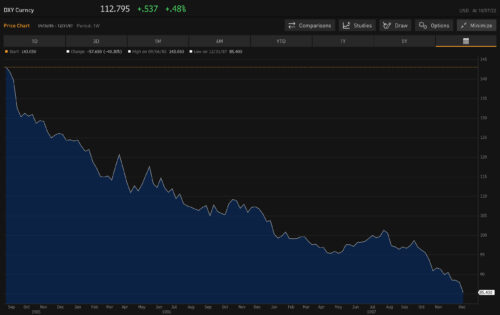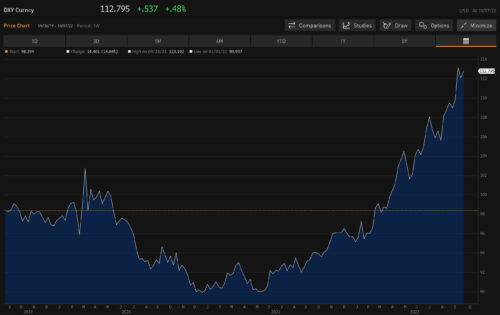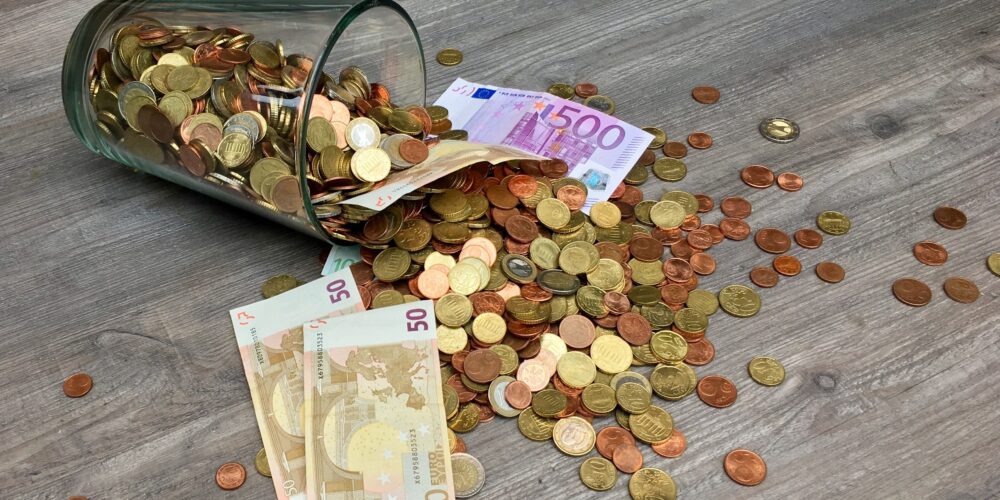✌️ Welcome to the latest issue of The Informationist, the newsletter that makes you smarter in just a few minutes each week.
🙌 The Informationist takes one current event or complicated concept and simplifies it for you in bullet points and easy to understand text.
🧠 Sound smart? Feed your brain with weekly issues sent directly to your inbox here
Today’s Bullets:
- The original Plaza Accord
- Why speculation of an Accord 2.0?
- What’s different today?
Inspirational Tweet:
Goldman Sachs Not Seeing Plaza Accord 2.0 Environment Yet: BBG
Plaza Accord 2.0 it is
— zerohedge (@zerohedge) September 30, 2022
Is there a Plaza Accord 2.0 on the horizon?
Goldman Sachs says no, and Zerohedge gives a tongue-in-cheek yes. But we’ve been hearing this debate for weeks now, and it’s starting to heat up with the continued strength of the USD.
So, what exactly was the Plaza Accord, and why are people speculating about a version 2.0?
Let’s break it down nice and easy, as always, right here today, and see if we can come to a conclusion ourselves.
🤝 The original Plaza Accord
First, what exactly was the original Plaza Accord, and why was it so important?
The Plaza Accord was an agreement in September, 1985 between the UK, West Germany, France, Japan, and the US to depreciate the USD versus all those currencies (remember, pre-Euro here, so that was the British pound, German Deutschmark, French franc, and Japanese yen).
It was named the Plaza Accord, because the agreement was signed in the famous Plaza Hotel bordering Central Park in New York City.
But why did they do this?
Put simply, with the 1980’s Fed battling inflation and raising interest rates to dizzying heights, the USD gained strength as the US Treasury market attracted investment for high returns. This happened because foreigners who wanted the high interest rates of Treasuries had to buy USD to invest here.
And here’s what resulted for the USD:

Exactly. It basically gobbled up all major currencies against it and strengthened unchecked. This, of course, hurt US companies who were major exporters, namely US automakers and equipment manufacturers like Caterpillar, along with tech companies like IBM and Motorola. See, as they sold their cars and equipment overseas, foreigners had to pay higher prices in their local currencies to compensate for the cost in USDs. So, these companies lobbied heavily for price protection against foreign competition.
They argued that because their lowered profits were hurting GDP, the US deficit was growing (over -3.5%), and eventually won politicians over.
The Plaza Accord was struck and the participants worked together to weaken the USD by buying all of their own currencies against it and vice versa.
That resulted in a sharp drop in USD valuation of over 40% in just a few years.

There’s plenty of argument over how effective the move was to fix the actual trade deficits, but there’s no question that the Plaza Accord was effective in weakening the USD.
So, why are we taking about another Plaza Accord today?
🤔 Why speculation of an Accord 2.0?
If you’ve been following 🧠The Informationist Newsletter, then you’ve read about the recent strength of the USD, as measured by the DXY. If you haven’t seen that yet and want a little deeper context, you can find it right here.
In short, though, as the Fed has aggressively been raising rates while other developed countries have lagged, this has caused both a flight to higher returns as well as a flight to safety to the USD from foreigners.
The result?
The USD is once again on the move higher this year.

And once again, we’re hearing rumblings from large US multinational companies who do a ton of business outside the US and want some USD relief. And this time we aren’t only hearing from other foreign countries, but now the UN itself, claiming the Fed is damaging smaller economies by raising interest rates and causing USD strength globally.
Additionally, it looks like the US Treasury is about to run into a major deficit problem with the dual impact of lower tax revenues from the bear market (capital gains taxes will be way down this year) and higher net interest expense due to higher cost of refinancing any maturing debt in the US.
So, with all this outside pressure and the tax vs. spending problem on the horizon, it would make sense to reach out to the major countries and strike another accord to weaken the USD against them, right?
No brainer. Just sign a Plaza Accord 2.0!
Not so fast, there, sparky. Times have changed since the 80’s, and not just the hairstyles and shoulder pads. The world is different today, and a Plaza Accord 2.0 may not do the trick this time.
⛔️ What’s different today?
First and foremost, as we’ve heard ad nauseam from the various Fed governors and their endless stream of media spots, the main goal of the US Fed today is still to bring down inflation.
Volcker had already slayed that beast by 1985, and it was no longer the main goal for the Fed back then.
Today, the Fed has all but declared war on US employment and is actually hoping for people to lose their jobs in order to help its cause. The Fed doesn’t care about multinational profits, so long as their decrease doesn’t impair the US Treasury’s ability to continue to sell bonds. And that is a long way off.
Also, the fact is, a strong USD actually helps fight inflation.
How?
Because the US economy is a net importer, the cost of goods being imported by consumers decreases as the USD gets stronger.
I.e., a stronger USD buys more foreign goods at cheaper rates.
In fact, Morgan Stanley estimates that the current USD appreciation is roughly equivalent to an increase of about 40bp interest rate hike by the Fed (Source: New York Times). Put bluntly, the US Fed is exporting its inflation problem to foreign countries.
Enter the UN now demanding they stop it. 🙄
But let’s be honest. While the USD has appreciated rapidly this year, it’s still nowhere near as strong today as it was in the 1980’s.
Look at the charts above and see the DXY is now at 112 vs back then when it was above 160.
Again, until it truly presents a trade deficit and revenue problem, the US has little incentive to weaken the USD just yet.
And finally, even if the US wanted to push for a Plaza Accord 2.0, as you may have guessed from the list of participants in the original accord, the currencies and players have changed since then.
For starters, West Germany is now Germany, and the franc and Deutschmark are now the Euro. So, major trade partners and players today include the EU, the UK, Japan, and China.
And there’s the rub.
China right now is a major (read: the major) trade partner of the US and others, and so any accord signed that doesn’t include China would be pretty ineffective as a whole. And China pretty much has no reason to come to the table, as they’re having their own economic issues, one that a stronger yuan would not solve for them.
So, as for me, I’m yet to jump aboard the Plaza Accord 2.0 train and predict its inevitably. Until the US has enough internal pressure to push for China and the others to come to the table, or until the USD becomes so strong that the Treasury starts having trouble selling bonds to fund its massive deficit—as far as the Fed is concerned, the world will just have to deal with a stronger USD.
And that, my friends, means if you’ve been wanting to take a trip to Europe or Japan, now may be the perfect time to get away.
That’s it. I hope you feel a little bit smarter knowing about the Plaza Accord and understand why we may not yet see a Plaza Accord 2.0 come to fruition.
Before leaving, feel free to respond to this newsletter with questions or future topics of interest. And if you want daily financial insights and, you can always find me on Twitter!
Thank you both, I sincerely appreciate it!
Thanks again, everyone, and talk soon!
✌️James










